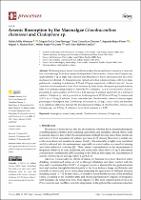Arsenic Biosorption by the Macroalgae Chondracanthus chamissoi and Cladophora sp.

View/
Author(s)
Otiniano, Nélida Milly
De La Cruz-Noriega, Magaly
Cabanillas-Chirinos, Luis
Rojas-Flores, Segundo
Muñoz-Ríos, Miguel A.
Rojas-Villacorta, Walter
Robles-Castillo, Heber
Date
2022-09Metadata
Show full item recordPublisher
MDPI
Journal
Processes 2022
Abstract
The biosorption of arsenic (As) with macroalgae has aroused much interest as a clean and
low-cost technology. To evaluate arsenic biosorption by Chondracanthus chamissoi and Cladophora sp., approximately 5 kg of algae was collected from Huanchaco’s beach and Sausacocha lake (Huamachuco), La Libertad. As biosorption was carried out in four column systems, with 2 g of algae pellets each, circulating As solutions of 0.25 and 1.25 ppm, respectively, at 300 mL/min cm2. As concentration was determined at 3 and 6 h of treatment by flame atomic absorption spectrophotometry. Data were analyzed using Student’s t-test with 95% confidence. At 6 h, Chondracanthus chamissoi presented an As biosorption of 95.76% in a 0.25 ppm mg/L solution and 85.33% in a 1.25 mg/L solution. Cladophora sp., at 6 h, presented an As biosorption of 95.76% in a 0.25 mg/L solution and 42.03% in a 1.25 mg/L solution. It was concluded that Chondracanthus chamissoi achieves higher percentages of biosorption than Cladophora sp. in solutions of 1.25 mg/L As (p < 0.05), and that there is no significant difference between the biosorption percentages of Chondracanthus chamissoi and Cladophora sp. in a 0.25 mg/L solution of As at 6 h of treatment (p > 0.05).
Type
info:eu-repo/semantics/article
Rights
info:eu-repo/semantics/openAccess
Language
eng
Collections
- Ingeniería Ambiental [98]

